Mastering Kite Surf Lessons in Miami: A Complete Guide

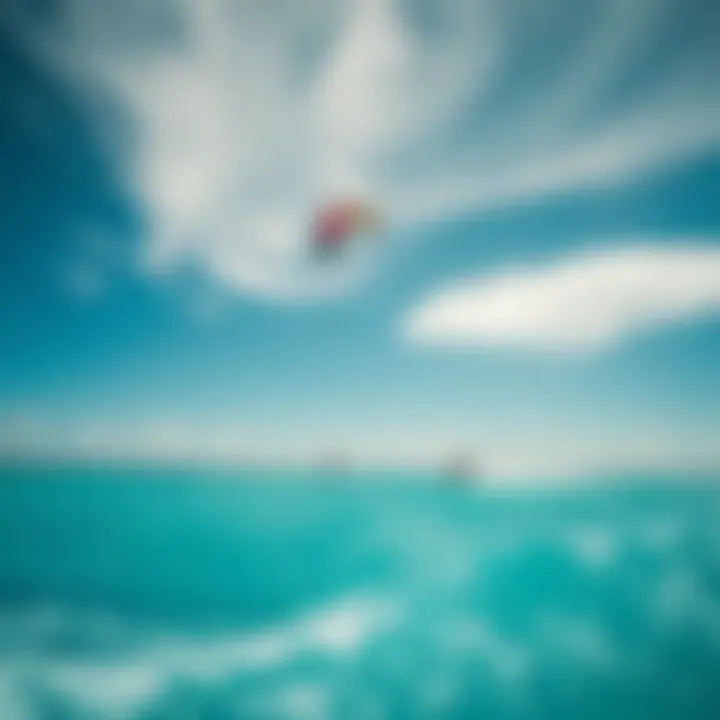
Intro
Kite surfing is not just a sport; it’s a thrilling way to connect with Miami’s stunning beaches and vibrant ocean. When you step into the world of kite surfing, you’re entering a domain where wind, water, and skill come together to create an exhilarating experience. Understanding the lessons in Miami can unlock a whole new level of enjoyment, whether you’re just starting out or looking to refine your techniques.
Kite surfing combines elements of traditional surfing, windsurfing, and paragliding. The learning process involves mastering various aspects—choosing the right equipment, understanding safety protocols, and developing the appropriate techniques. In a city like Miami, with its year-round favorable weather and sprawling coastline, it’s a prime spot for kiteboarders of all levels. Let's take a closer look at the foundations that make up the kite surf experience.
Equipment Insights
Latest Gear Reviews
The heart of kite surfing lies in the equipment. Knowing the latest gear on the market can significantly influence your learning experience. One popular kite spinning waves is the Slingshot Rally. Known for its versatility, it’s suitable for newbies and seasoned surfers alike. The kite is designed to be stable in various wind conditions, enabling those just starting to focus more on learning rather than fighting their equipment.
For the board, the Liquid Force Heart is a favorite among many. Its buoyant design allows for easy take-offs and landings. Having the right board can empower newcomers to improve their confidence. If you’re looking for the latest advancements, dive into reviews on forums like https://www.reddit.com/r/Kitesurfing/. There you can read about others’ experiences and make informed choices based on real feedback.
Essential Gear Maintenance
Just as you wouldn't drive a car without regular check-ups, kite surfing gear requires upkeep. A simple but effective maintenance routine can prolong the life of your equipment and ensure safety during those exhilarating rides.
- Kite: Rinse the kite with fresh water after each session to remove salt and sand that can wear down the fabric. Store it in a cool, dry place to prevent materials from degrading under sunlight.
- Lines: Regularly inspect the lines for fraying or damage. Replace them if you spot any issues to avoid catastrophic failures while out on the water.
- Board: Ensure to regularly check the board for dings or scratches. A well-maintained board provides a smoother ride and better performance.
Taking care of your gear not only enhances your safety but also contributes to the overall experience.
Technique Exploration
Beginner Techniques
Many newcomers often wonder where to start. The first step in mastering kite surfing is learning to control the kite on land. This includes practicing power strokes and understanding how wind direction affects movement. You want to feel comfortable with the kite before it ever hits the water.
Once you’re ready, transitioning to water starts with the body-drag technique. It involves being dragged by the kite while in the water. This phase teaches valuable lessons about kite control and body positioning without the added challenge of a board.
Advanced Maneuvers
As you gain confidence, moving towards advanced techniques will allow you to fully harness the adrenaline of the sport. Tricks like jumps and spins require precise control and timing. It's beneficial to practice flying the kite with quick, responsive movements to build muscle memory.
Incorporating jumps into your routine can be exhilarating. It may feel intimidating at first, but persistence is key! Most successful kiteboarders advise focusing on mastering techniques one step at a time.
"The beautiful thing about kite surfing is that every session, you learn a bit more about yourself and the ocean. It’s an ongoing journey of improvement."
Participating in lessons structured around guiding you through these techniques will help fast-track your learning process. Finding certified instructors in Miami is crucial to ensure a safe and enriching experience.
Keeping these aspects in mind as you embark on your kite surfing journey can help lay the foundation for a rewarding adventure out on the fantastic waves of Miami.
Prolusion to Kite Surfing
Kite surfing stands out as a compelling water sport that merges the thrill of surfing with the exhilaration of flying a kite. Understanding kite surfing’s nuances, especially in a location like Miami, opens up a world of opportunity for both novices and veterans alike.
Kite surfing is not just a pastime; it’s a lifestyle that offers adrenaline-pumping excitement. Moreover, the sport welcomes enthusiasts from various backgrounds, encouraging individuals of all skill levels to participate. Notably, Miami's vibrant climate and beautiful beaches contribute to a perfect setting for learning and refining skills.
The Evolution of Kite Surfing
Kite surfing’s journey can be traced back to ancient times, with various forms of kite work found in cultures as far back as the Chinese and Polynesian civilizations. However, the modern variant began taking shape in the late 20th century. Around the 1980s, the introduction of inflatable kites revolutionized the sport, making it more accessible and easier to control.
This transformation continued into the 1990s when the sport saw a surge in popularity, thanks to innovations in board design and safety gear. The progression didn’t stop there; techniques and methods for kite surfing evolved, creating a diverse array of styles, including freestyle and wave riding. Each adaptation has brought greater complexity and sophistication to the sport, continually attracting new participants.
Why Choose Miami for Kite Surfing
Miami offers a unique blend of attributes that make it a premier destination for kite surfing. The first highlight is the beautiful wide beaches combined with warm, consistent winds nearly year-round. For those starting out, this climate provides a safer and more enjoyable learning environment.
Additionally, the city is home to a vibrant kite surfing community with numerous schools and instructors eager to share their expertise. Having the option to learn from seasoned professionals adds immense value, enabling first-timers to grasp skills quickly and effectively.
But it doesn’t stop there - Miami itself has a lively and diverse atmosphere, giving lessons a thrilling backdrop. This cultural infusion enhances the entire experience — it’s not just about learning to kite surf; it’s about immersing oneself in the local vibe.
"Kite surfing in Miami isn’t just a sport; it’s a gateway to community, culture, and connection with nature."
In essence, choosing Miami for kite surfing lessons means tapping into a rich treasure trove of experiences. The combination of favorable conditions, expert instructors, and an enthusiastic community indeed makes it a top pick for anyone looking to dive into this exhilarating sport.
Overview of Kite Surf Lessons in Miami
Kite surfing has transformed into a popular water sport that attracts both thrill-seekers and those who appreciate the serene beauty of Miami's coastline. The lessons offered in this vibrant city cater to a range of participants—from absolute beginners to seasoned kiteboarders looking to refine their skills. It’s important to understand the landscape of kite surf lessons in Miami as they not only equip you with essential skills but also immerse you in the local culture and the camaraderie among fellow enthusiasts.
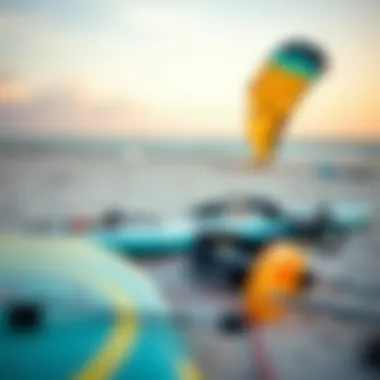
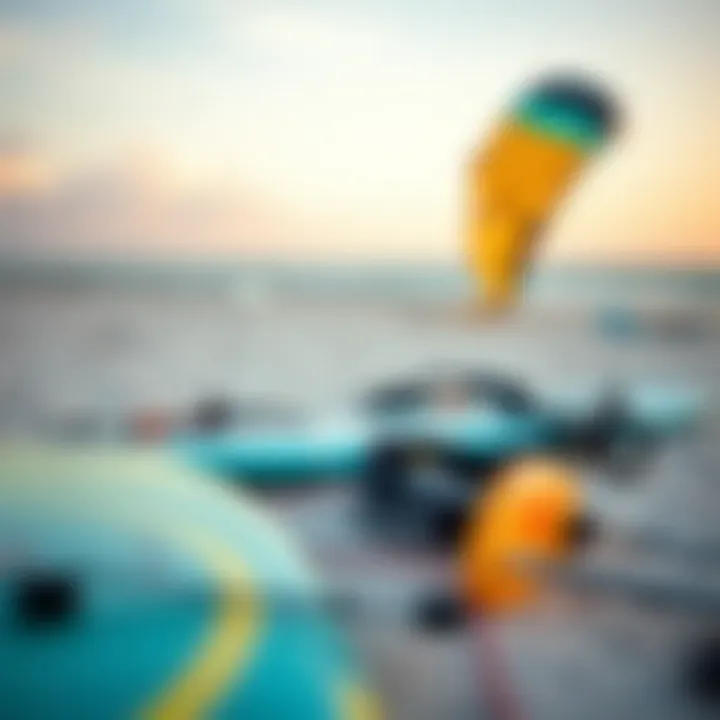
Types of Lessons Offered
Kite surf schools in Miami provide a variety of lesson formats designed to fit different learning preferences, schedules, and abilities. Here’s a closer look at what you can find:
- Private Lessons: For those who want individualized attention and a tailored experience, private lessons are perfect. Instructors can focus solely on your strengths and weaknesses, providing direct feedback and enhancing your learning curve.
- Group Lessons: These lessons are more social and can create a fun atmosphere for learning. Participants can bond over shared experiences, making it ideal for those who enjoy learning with others.
- Beginner to Advanced Classes: Lessons are typically structured from beginner to intermediate and advanced levels. Beginners start with land-based training and progress to water lessons as they gain confidence.
- Specialized Courses: Some schools offer specialized training, such as freestyle, wave riding, or even safety techniques. These courses are beneficial for experienced kite surfers looking to sharpen specific skills.
"Kite surfing is not just a sport; it’s a lifestyle. Embracing the lessons offered in Miami can ignite a profound love for the ocean and the art of riding the wind."
Understanding the types of lessons available will allow one to select the format that best meets their personal learning style, goals, and overall aspiration in the sport.
Lesson Structure
The structure of kite surf lessons in Miami is designed to provide a comprehensive and engaging experience. Here’s what one might expect during a typical session:
- Introduction and Safety Briefing: Every lesson kicks off with a safety briefing to outline crucial dos and don’ts. Instructors make sure every student understands safety protocols, gear handling, and environmental awareness.
- Gear Setup: Students learn about the essential gear, how to set it up properly, and the importance of inspecting equipment before taking to the water. Understanding your gear enhances safety and performance.
- Ground Training: Before hitting the waves, ground training takes place. This part covers kite control skills on land, which is essential before tackling the water. Practicing how to manage braking, turns, and the overall feel of the kite lays the groundwork for water maneuvers.
- Water Practice: Once comfortable on land, students transition to water practice. This phase involves body dragging, board starts, and learning how to move confidently across the surface.
- Feedback and Assessment: Instructors will typically offer constructive feedback throughout the lesson, ensuring that students understand not only what to do but why it matters. This reflection is crucial for ongoing improvement and skill development.
Remember, the key to successful kite surf lessons lies in the balance between instruction and practice. With Miami's favorable wind conditions and spacious beaches, students can expect an engaging learning process that paves the way for an exciting journey in kite surfing.
Understanding the Equipment
When stepping into the realm of kite surfing, having a sound grasp of the equipment involved is crucial. The right gear not only enhances performance but also impacts safety and enjoyment while soaring across the azure waters of Miami. This section aims to dive deep into the essentials and advanced components of kite surfing equipment, catering to newcomers who may feel like they've walked into a foreign land, as well as seasoned kiteboarders who are looking for that edge.
Essential Gear for Beginners
For beginners, kite surfing gear might seem overwhelming, like trying to decode a secret language. Having the right equipment helps simplify the learning curve and makes those first rides on the water much more manageable. Here's a snapshot of what every novice should consider:
- Kite: This is your lifeline in the water. Beginner kites are generally wider and more stable, which translates to a forgiving experience for those just starting out. A popular choice for newbies is the Cabrinha Switchblade, known for its ease of use.
- Control Bar: This piece is vital for steering the kite and managing power. Opt for a bar with a safety system that’s simple to understand – your future self will thank you later.
- Harness: The harness transfers the kite's pull to your body, allowing for comfort while riding. Beginners might prefer a seat harness, which offers more support, akin to sitting in a comfy chair.
- Board: Beginners generally benefit from a larger board, as it provides better stability on the water. The Slingshot Misfit is a solid entry-level board that many find user-friendly.
- Safety Gear: A life jacket should be a no-brainer. It keeps you afloat in case you fall, literally turning the tide on potentially dangerous situations.
Utilizing this equipment will not only enhance your experience but also instill confidence as you learn the ropes of kite surfing. Remember, each person’s preferences matter. Don’t hesitate to talk to your instructor about what gear they recommend based on your needs.
Advanced Equipment for Professionals
For those who have transitioned from novice to more experienced kiteboarders, the landscape of equipment choice evolves significantly. Professionals crave performance. They want gear that allows them to push limits while ensuring safety, and that’s where advanced equipment shines.
- High-Performance Kites: These kites often have a more complex design; they are usually lighter and built for speed and maneuverability. The North Orbit is a go-to kite for many pro kite surfers who desire precision and agility in their rides.
- Specialized Boards: Advanced riders may opt for twintip or directional boards, depending on their style. A twintip like the Liquid Force Rocket often suits those who enjoy tricks and jumps, while directional boards are preferred by those who gravitate towards waves.
- Hydration Systems and Wearables: Long sessions can lead to dehydration. Advanced riders can benefit from hydration systems that secure water bottles on the harness. Smart wearables monitoring heart rates or GPS tracks can also provide performance insights, keeping the rider always a step ahead.
- Technical Accessories: Items like kite repair kits, additional line sets, and bar adjustments can make all the difference during an extended kite session, ensuring everything runs smoothly.
Investing in advanced equipment not only speaks to a rider's passion but also their commitment to mastering the sport. As they elevate their skills, the ability to adapt their gear accordingly is vital for further progression. The real challenge lies in harnessing the full capabilities of each piece of equipment and melding it with one’s unique riding style.
"The more you know about your gear, the better you can navigate the challenges that come with kite surfing."
Understanding kite surfing equipment goes beyond just learning its components; it’s about ensuring safe practices and enhancing the overall kiteboarding experience in the popular Miami waters.
Choosing an Instructor
Selecting the right instructor for kite surfing is more than just picking a name off a list; it’s about finding a mentor who can guide you through the exhilarating waters of Miami’s coastline. This decision carries significant weight as the instructor plays a pivotal role in your learning curve and overall experience. With the right teacher, not only will you grasp the fundamentals more effectively, but you'll also build confidence in the water. Therefore, it is essential to focus on specific qualifications and teaching styles that suit your learning needs.
Qualifications to Look For
When searching for an instructor, there are several key qualifications that should not fall through the cracks. First and foremost, ensure the instructor is certified by recognized organizations like the International Kiteboarding Organization (IKO) or the British Kite Sports Association (BKSA). These certifications indicate that the instructor meets international safety and training standards.
In addition, check how many years of experience the instructor has. Someone who has spent considerable time out on the water brings a wealth of knowledge. Their experience might mean knowing how to read the wind conditions effectively or managing unexpected situations that arise on the water. A well-rounded instructor can translate complex techniques into understandable lessons.
Furthermore, look for testimonials or reviews from previous students. A glowing review can often be a good indicator of what you should expect. Pay attention to aspects like how the instructor communicates and whether students felt safe and supported during their lessons.
Teaching Styles and Approaches
Every instructor has their own approach to teaching kite surfing. Understanding these styles can help you select an instructor who aligns with your learning preferences. Some instructors emphasize hands-on, personalized guidance, which can be advantageous for those who appreciate direct feedback. They may take time to demonstrate techniques while providing step-by-step directions, allowing students to absorb the information more fully.
Others may adopt a more exploratory approach, encouraging students to experiment under their watchful eye. This method allows learners to discover kiteboarding at their own pace, which can foster a deep sense of confidence. You should try to find an instructor who balances structured lessons with opportunities for individual exploration, providing a comprehensive approach to the sport.
Overall, consider an instructor's teaching style as a reflection of your own learning preferences. A great match here can significantly impact your journey from a beginner to a capable kiteboarder.
"The right instructor can make or break your kiteboarding experience. Choose wisely."
By focusing on qualifications and teaching styles that resonate with your personal learning style, you enhance the chances of surfacing not just as a skilled kiteboarder but also an enthusiastic participant in the vibrant Miami kiteboarding community.
Safety Considerations
When it comes to kite surfing, safety is not just a precaution; it’s a fundamental aspect that can make or break your entire experience on the water. Miami’s beautiful beaches may seem inviting, but understanding the potential risks involved is crucial. Familiarity with safety protocols not only protects you but ensures everyone else in the vicinity can enjoy this exhilarating sport without a hitch. Kite surfing, with its combination of wind, water, and speed, requires a mindful approach to mitigate injuries and uphold a fun and secure environment.
Understanding Currents and Tides
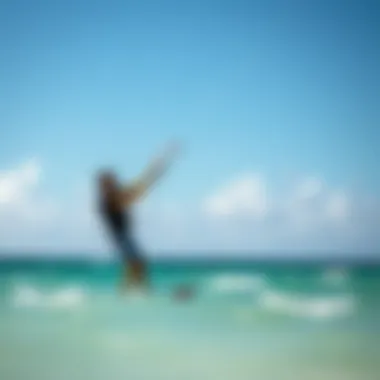
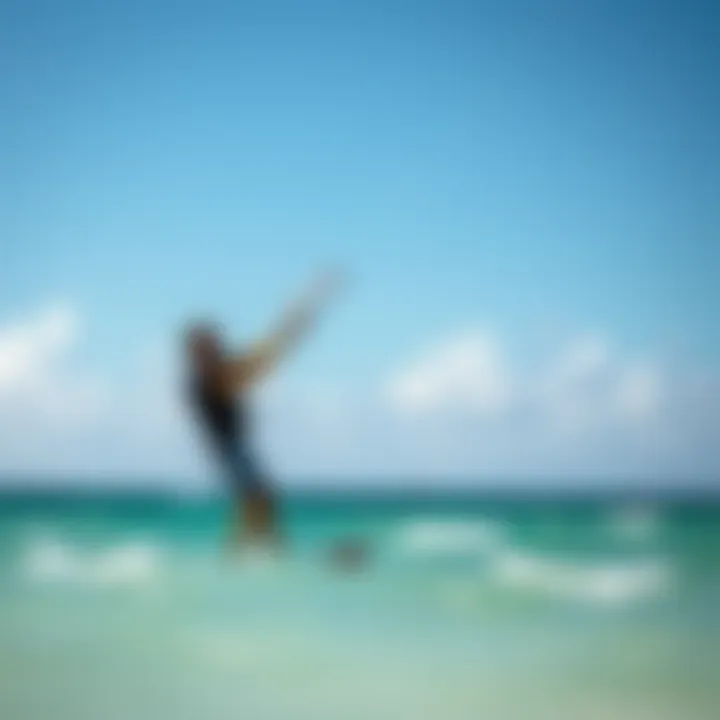
Miami’s coastal waters are dynamic, influenced daily by tides and currents that can be tricky for the untrained eye. Not recognizing the significance of these elements may lead to unforeseen dangers. For instance, during outgoing tides, it’s common for some areas to experience stronger currents, potentially pulling even the most seasoned kite surfers away from their intended course.
Before hitting the water, it’s vital to check the local tide charts. The best resources for this information often come from apps like Tides Near Me or websites like tide-forecast.com. This knowledge allows kitesurfers to plan their sessions around favorable conditions. In addition, being aware of local landmarks can help with orientation, ensuring you don’t end up drifting into more challenging waters.
"Knowing your surroundings and respecting the nature of the sea separates experienced kite surfers from novices."
One practical way to stay safe is to observe other riders and their reactions to the current. If they seem to be struggling, it might be best to rethink your plan and stay closer to the shore until conditions are more favorable. Always remember that understanding your limitations, combined with genuine awareness of the tides and currents, is what keeps kite surfing enjoyable and safe.
Personal Protective Equipment
Personal protective equipment (PPE) isn’t just a choice; it’s an essential part of kite surfing. Whether you’re a beginner or a seasoned kiteboarder, safety gear can be your best friend when things take an unexpected turn. The primary goal of PPE is to shield you from injury caused by equipment or environmental factors, and choosing the right gear can significantly boost your confidence on the water.
For starters, a quality helmet can protect your noggin during falls or collisions. Alongside that, wearing impact vests can help cushion against water impacts, especially in a hard tumble. The winds can sometimes throw you about like a ragdoll, and having that extra padding can make a world of difference.
Foot protection is often overlooked, yet it plays a crucial role. Booties provide grip on the board while protecting your feet from sharp objects lurking beneath the surface. What’s more is that they keep your feet warm, especially during the cooler months.
Lastly, a reliable harness is indispensable. A well-fitted harness will help distribute the load across your body, reducing strain and enhancing your control. When buying equipment, it’s wise to consult with instructors or local shops about what works best for your riding style.
In summary, investing in proper protective gear should never feel like an afterthought. By prioritizing your safety through well-chosen PPE, you can enjoy kite surfing in Miami while having peace of mind, focusing instead on mastering your skills.
Physical Conditioning for Kite Surfing
Kite surfing isn't just about flexing your muscles and holding a kite; it's a rigorous sport that demands a fair bit of physical conditioning. If you're looking to carve through the water like a pro or smoothly control the surf, getting your body in tip-top shape is essential. Beyond the obvious fun of riding the waves, being physically fit can make all the difference in your ability to navigate the unpredictable elements of kite surfing.
Pre-Lesson Training Recommendations
Getting into kite surfing requires not just enthusiasm but also a body that's prepared for the physical demands. Here are some pre-lesson training recommendations to help boost your performance:
- Strength Training: Focus on building core strength since it supports balance while you’re maneuvering on the board. Planks, squats, and deadlifts are excellent exercises to incorporate into your routine.
- Endurance Work: Kite surfing often means long periods of activity. Cardio exercises, such as running or cycling, will effectively improve your stamina.
- Flexibility Exercises: Incorporating yoga can significantly enhance your flexibility which is crucial for movements involved in both flying a kite and navigating the board. Even simple stretching can do wonders.
- Swimming: Being comfortable in water is paramount, so having a strong swimming background adds to your confidence when you’re kite surfing.
To put it simply, don’t just jump on a board without preparation. Having a strong foundation will not only enhance your performance but also allow you to enjoy the ride without running into unnecessary exhaustion.
Injury Prevention Techniques
No one wants to face the grim prospect of an injury that puts a damper on their kite surfing journey. Being proactive about injury prevention is critical. Here are some techniques to keep in mind:
- Warm-Up and Cool Down: Always stretch before getting on the board to prevent muscle strains. After your session, take time to cool down; it helps in muscle recovery.
- Listen to Your Body: If something feels off during a lesson, don’t power through it. It's much better to stop and reassess rather than risk an injury that sidelines you for weeks.
- Proper Equipment Usage: Wearing the right gear is vital. Make sure your harness fits well, and check your board for any damages before heading into the waves. This simple check can save you from a nasty tumble.
- Work on Balance: Certain exercises focusing on balance can significantly reduce the risk of falls. Balance boards or stability balls can be fantastic adjuncts to your workouts.
Remember, kite surfing should be about enjoying the thrill, not about nursing injuries. Take the time to condition yourself properly and prevent mishaps before they happen.
By understanding and prioritizing physical conditioning, you can greatly enhance your kite surfing experience in Miami. The waves are calling, but they want you to come prepared to truly enjoy every ride.
What to Expect During Lessons
Kite surfing lessons in Miami are not just about learning to ride the waves; they’re an introduction to a dynamic lifestyle that blends skill, thrill, and safety. The experience can be a bit daunting for beginners, but knowing what to expect can ease those jitters. From the very first lesson, potential kite surfers will find themselves immersed in both technical training and the exhilarating environment that Miami has to offer.
Understanding what happens during lessons is crucial for learners. This helps them to mentally prepare, making the entire process smoother and more enjoyable. Being knowledgeable about the expectations can significantly enhance the learning journey and ensure one maximizes their time on the water.
First Time Experience
For a first-time kite surfer, the experience is likely to be a potpourri of emotions ranging from anticipation to nervousness. Your first lesson will generally start with an orientation session, introducing the basic theory of kiteboarding. It usually involves explanations of wind patterns, kite controls, and safety protocols, which may feel overwhelming. However, these fundamentals are key for ensuring a successful kiteboarding adventure.
You'll spend a good portion of the lesson getting familiar with the kite on the beach before even touching the water. Instructors often start with a small kite, one that is manageable for beginners.
You'll learn hands-on how to handle the kite, launch it safely, and steer it while keeping your balance. The first time you lift off the ground, even for just a moment, can be exhilarating. However, don’t underestimate the coordination and mental focus required. Here’s a brief insight into what you can expect on that first day:
- Safety Briefing: You’ll learn the safety protocols that are essential for a fun and worry-free experience.
- Kite Setup: Understanding how to rig your equipment is crucial.
- Practice Kiting: You will practice flying the kite while standing on the beach.
- Water Time: Depending on your comfort level, you might take your first tentative steps on the board.
Above all, remember that everyone was once a beginner. The key is to have fun while developing your skills, even if it feels slightly intimidating.
Common Challenges and Tips
Even the seasoned pros had their fair share of ups and downs while learning. A typical challenge for new students is overcoming the fear of the kite’s power. The wind can be your greatest ally or your biggest foe, and managing that dynamic takes practice. Here are a few common hurdles you might face:
- Controlling the Wind: Learning to read the wind can feel like deciphering a foreign language. Not every gust is equal, and understanding how your kite reacts can take time.
- Building Muscle Memory: The motions needed to steer the kite and balance are not always intuitive. Expect to practice these movements repeatedly.
- Falling: It’s part of the process. Expect to wipe out a few times (or a lot). Embrace these moments, as they invariably lead to improvement.
To tackle these challenges, consider the following tips:
- Stay Relaxed: Tension will only hinder your performance. Try to keep your body loose and responsive.
- Ask Questions: Don’t hesitate to reach out to your instructor if you’re unsure about something. They are there to guide you.
- Practice, Practice, Practice: The more time you spend on the water, the quicker you'll improve.
A positive mindset can make all the difference. Remember, every kite surfer started where you are now, and perseverance is key. With each lesson, you’ll not only learn the sport but also grow to love the incredible waters of Miami.


Post-Lesson Development
Post-lesson development is a crucial facet of any kite surfing journey. Just completing a few lessons won't magically make you a pro on the water. Instead, it’s about what you do afterwards that solidifies your skills and helps you become a confident kiteboarder. Continuing to practice and improve your abilities after lessons is where the real growth happens.
Continued Practice and Improvement
After the initial lessons, it's vital to keep that momentum going. Regular practice serves multiple purposes:
- Skill Reinforcement: The skills learned during lessons can fade if not practiced regularly. Think of it as muscle memory; the more you do it, the easier it becomes.
- Confidence Building: The more you kite surf, the more comfortable you become with the equipment and the conditions. This confidence is essential, especially when facing challenges or varying weather conditions.
- Exploration of Techniques: Engaging in different styles and techniques helps in becoming a versatile kiteboarder. Try moving from basic upwind riding to tackling jumps or tricks as you progress.
To maximize your practice sessions, consider the following:
- Set specific goals for each session, like perfecting your landing or improving your transitions.
- Record your sessions, even if just on your phone, to assess and identify areas that need work.
- Don't shy away from feedback; get tips from fellow kiteboarders or ride along with a more experienced partner.
- Try to find the right conditions, so you can practice safely without feeling overwhelmed by strong winds.
Engaging with the Community
Kiteboarding is not just about hitting the waves alone; it’s about being part of a vibrant community. Engaging with fellow kite surfers can enhance your experience significantly. Here’s how:
- Shared Knowledge: Local kiteboarding groups often share tips, tricks, and techniques. You never know what you might learn from an advanced kiteboarder sharing their insights over local beers.
- Networking Opportunities: Connections in the kiteboarding community can lead to new friends, riding partners, or even future sponsorship opportunities if you’re aiming to take it more seriously.
- Group Events and Competitions: Joining in on group outings or local competitions can push you to test your skills under pressure, which can be a big motivator for improvement.
Engage in community activities through:
- Social media groups, such as on Facebook or Reddit, where kiteboarders congregate to share experiences or arrange meet-ups.
- Local clubs or organizations that may organize events, workshops, or even social outings.
Being a part of the kite surfing community not only enhances your skills but also fosters camaraderie among riders.
"The best surfer out there is the one having the most fun."
In summary, post-lesson development is not just a phase; it’s a lifelong journey of improvement, connection, and growth on the water.
Popular Locations for Kite Surfing in Miami
Kite surfing is not just about the thrill; it heavily hinges on where you ride the wind and water. Miami, with its stunning landscapes and ideal wind conditions, offers a plethora of options for both newcomers and experienced riders. Understanding the best spots can significantly impact your learning experience and enjoyment. The landscapes, wind patterns, and meeting fellow enthusiasts help nurture a vibrant kite surfing culture in the area.
Best Beaches for Learning
When it comes to learning, the right beach can make all the difference. Newer kiteboarders should look for locations that offer ample practice space with gentle waves. A few top picks include:
- Virginia Key Beach: This spot is particularly favored by beginners due to its nearly endless sandy shoreline and shallow water that allows for safe crashes and rises.
- Hobie Beach: Located near Key Biscayne, Hobie Beach has steady winds and is often populated with instructors and learners alike, creating a supportive environment.
- Crandon Park: This beach offers calm waters and consistent wind. It’s perfect for practicing basic maneuvers without the worry of heavy surf.
These locations provide an ideal environment where students can focus on mastering external conditions, helping them build confidence before plunging into more demanding waters. Always check local regulations and beach conditions to ensure a safe experience.
Locations for Seasoned Kiteboarders
For the seasoned kiteboarder, the adventure doesn’t stop as they move past basic lessons. Veteran riders seek out more challenging locations to hone their skills. In Miami, these include:
- Key Biscayne: This gem is popular among advanced riders due to its varied conditions, making it perfect for attempting jumps and tricks.
- Matheson Hammock Park: Known for its picturesque settings, Matheson offers phenomenal wind and broad water space ideal for practitioners looking to refine their techniques.
- South Beach: Although it can get crowded, the atmosphere electrifies more experienced kite surfers seeking a vibrant, lively scene while riding.
Each of these locations presents unique challenges and thrills that seasoned boarders crave. The variety allows for a rich experience beyond just the sport, expanding one's skill set while also enjoying Miami's beautiful scenery.
Tip: Always consider wind direction and local advisories before heading out. It can make or break your day on the water!
Ending
In wrapping up the exploration of kite surf lessons in Miami, it's essential to recognize the myriad elements involved that shape this thrilling activity. From understanding the evolution of kite surfing to selecting the right instructor, every detail plays a pivotal role in ensuring a rewarding experience. Kite surfing not only offers exhilarating moments on the water but also supports personal growth as it demands focus, resilience, and adaptability. This article provided insight into factors like lesson structures, safety protocols, and popular locations, all crucial for both newcomers and experienced kiteboarders alike.
The benefits of kite surfing go beyond just mastering a sport; they include fostering a sense of community, enhancing physical fitness, and connecting with Miami's stunning natural environment. As many experienced riders can attest, becoming part of the kite surfing culture enriches the journey.
"Kite surfing teaches not only balance on the board but also balance in life. Every gust of wind is a new lesson."
Recap of Key Takeaways
- Types of Lessons: Miami offers a range of lessons tailored to varying skill levels, from beginners to advanced riders.
- Essential Equipment: Knowledge about necessary gear, from kites to safety harnesses, aids in making informed decisions about purchases and rentals.
- Instructor Selection: Importance of finding a qualified instructor who matches your learning style, ensuring a supportive and safe learning environment.
- Safety Protocols: Understanding local currents and tides is crucial for safety. Protective gear like helmets and impact vests are recommended.
- Continued Practice: Post-lesson, continuing to practice and engaging within the kite surfing community can significantly improve skills.
- Ideal Locations: Identifying the best spots for learning and advanced riding enhances the overall experience.
Encouragement for New Learners
For those taking their first steps into the world of kite surfing, it’s crucial to embrace the journey with an open mind. Recognizing that every expert was once a beginner can lighten the pressure you may feel. Start with lessons that feel right for your pace, and don’t be afraid to ask questions — instructors are there to guide you.
Connecting with fellow learners can provide motivation and camaraderie. Join forums on platforms like Reddit or Facebook to discuss experiences, share tips, and inspire each other. As you progress, celebrate small achievements and remember that setbacks are part of mastering any skill.
Dive into Miami’s vibrant kite surfing scene. The waves, the wind, and the community await you. Take the plunge, remain patient, and soon you’ll find yourself gliding across the water, soaking in the beauty of the moment.
Links for further information:
Explore, learn, and enjoy every moment of kite surfing in Miami!







